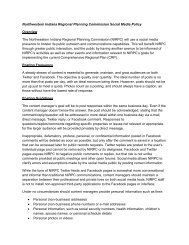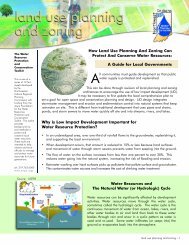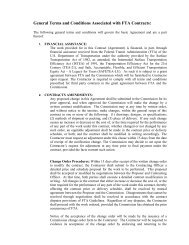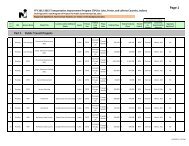Comprehensive Regional Plan - Northwestern Indiana Regional ...
Comprehensive Regional Plan - Northwestern Indiana Regional ...
Comprehensive Regional Plan - Northwestern Indiana Regional ...
You also want an ePaper? Increase the reach of your titles
YUMPU automatically turns print PDFs into web optimized ePapers that Google loves.
2040 CRP Summary / Human and Economic Resources<br />
ECONOMIC DEVELOPMENT STRATEGIES<br />
ADVANCE OUR TOP<br />
INDUSTRY CLUSTERS<br />
Lagging<br />
Change in Occupational Cluster Concentration in Northwest <strong>Indiana</strong>, 2002–2009<br />
1.8<br />
1.6<br />
Skilled Production Workers:<br />
Technicians, Operators, Trades,<br />
Installers, and Repairers<br />
Mature<br />
1.4<br />
64<br />
In order to properly gauge how our economy<br />
can compete, an evaluation of our economic<br />
“clusters” is necessary. These clusters are<br />
types of economic specializations that in<br />
combination offer a competitive advantage<br />
in the marketplaces. A number of potential<br />
clusters have emerged in Northwest <strong>Indiana</strong>.<br />
They include:<br />
• Transportation, Distribution and<br />
Logistics<br />
• Advanced Manufacturing<br />
• IT/Technology<br />
• Professional and Medical Services<br />
Note: The size of each bubble is based on the<br />
number of workers within each occupation<br />
cluster<br />
Source: Center for Workforce Innovations<br />
Northwest <strong>Indiana</strong> 2010 State of the<br />
Workforce Report.<br />
National Location Quotient, 2009<br />
Fading<br />
Public Safety and<br />
Domestic Security<br />
Arts, Entertainment, Publishing,<br />
and Broadcasting<br />
Information Technology<br />
Health Care and Medical Science<br />
(Therapy, Counseling, Nursing, and Rehabilitation)<br />
Legal and Financial<br />
Services and Real Estate<br />
Mathematics, Statistics,<br />
Data, and Accounting<br />
Managerial, Sales, Marketing,<br />
and Human Resources<br />
Natural Sciences<br />
and Environmental<br />
Management<br />
1.2<br />
1.0<br />
0.8<br />
0.6<br />
0.4<br />
0.2<br />
0<br />
Health Care and Medical Science<br />
(Medical Technicians)<br />
Personal Services Occupations<br />
Health Care and Medical Science<br />
(Medical Practitioners and Scientists)<br />
Building, Landscape, and<br />
Construction Design<br />
Agribusiness and Food Technology<br />
Engineering and<br />
Related Sciences<br />
Rising Stars<br />
–9% –7% –5% –3% –1% 1% 3% 5% 7%<br />
At the same time, these are the clusters most in need of strategies<br />
to compete in the global economy.<br />
Within each broad category, the individual Occupation Clusters<br />
can be further broken down into groups that are highly concentrated<br />
(an LQ of 1.2 or greater), lightly concentrated (between<br />
1.0 and 1.19), diffuse (less than 1.0 but greater than 0.8), or weak<br />
(less than or equal to 0.8). The highly concentrated clusters for<br />
Northwest <strong>Indiana</strong>, Skilled Production Workers and Health Care<br />
and Medical Science (Medical Technicians), are areas of strength<br />
for the Region. These are the clusters that are driving the regional<br />
economy and should be marketed to businesses that rely on<br />
these workers.<br />
The lightly concentrated clusters, Personal Service Workers, Health<br />
Care and Medical Science (Therapy, Counseling, Nursing, and<br />
Percentage Change in National Location Quotient, 2002–2009<br />
Sources: Purdue University Center for <strong>Regional</strong> Development; EMSI Covered Employment—1st Quarter 2010<br />
Note: The size of each bubble is based on the number of workers within each occupation cluster<br />
Rehabilitation), and Public Safety and Domestic Security, are also<br />
areas of strength for the Region, but more work needs to be done to<br />
convert them into highly concentrated workers. These are the clusters<br />
that need to make the leap from good to great so the economy<br />
can move forward.<br />
Diffuse and weak clusters need strategies to mitigate the Region’s<br />
deficiencies in these areas. Particularly disturbing are the collection<br />
of Fading clusters. These clusters are sources of high-wage jobs<br />
and are essential to innovation and regional competitiveness. The<br />
skills of workers found in management, mathematics, and information<br />
technology clusters are commonly cited as requirements<br />
by businesses that contribute to a truly competitive economy.<br />
<strong>Regional</strong> innovation and competitiveness in the global economy<br />
are threatened as long as these Occupation Clusters remain in the<br />
Fading category.<br />
42 www.innovativeworkforce.com 2010

















